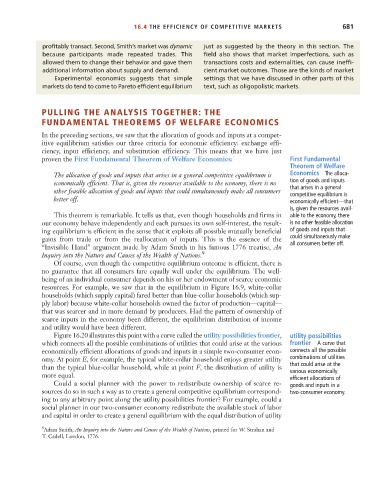Page 707 - Microeconomics, Fourth Edition
P. 707
c16GeneralEquilibriumTheory.qxd 8/16/10 9:14 PM Page 681
16.4 THE EFFICIENCY OF COMPETITIVE MARKETS 681
profitably transact. Second, Smith’s market was dynamic just as suggested by the theory in this section. The
because participants made repeated trades. This field also shows that market imperfections, such as
allowed them to change their behavior and gave them transactions costs and externalities, can cause ineffi-
additional information about supply and demand. cient market outcomes. Those are the kinds of market
Experimental economics suggests that simple settings that we have discussed in other parts of this
markets do tend to come to Pareto efficient equilibrium text, such as oligopolistic markets.
PULLING THE ANALYSIS TOGETHER: THE
FUNDAMENTAL THEOREMS OF WELFARE ECONOMICS
In the preceding sections, we saw that the allocation of goods and inputs at a compet-
itive equilibrium satisfies our three criteria for economic efficiency: exchange effi-
ciency, input efficiency, and substitution efficiency. This means that we have just
proven the First Fundamental Theorem of Welfare Economics: First Fundamental
Theorem of Welfare
The allocation of goods and inputs that arises in a general competitive equilibrium is Economics The alloca-
tion of goods and inputs
economically efficient. That is, given the resources available to the economy, there is no
that arises in a general
other feasible allocation of goods and inputs that could simultaneously make all consumers
competitive equilibrium is
better off. economically efficient—that
is, given the resources avail-
This theorem is remarkable. It tells us that, even though households and firms in able to the economy, there
our economy behave independently and each pursues its own self-interest, the result- is no other feasible allocation
ing equilibrium is efficient in the sense that it exploits all possible mutually beneficial of goods and inputs that
could simultaneously make
gains from trade or from the reallocation of inputs. This is the essence of the
all consumers better off.
“Invisible Hand” argument made by Adam Smith in his famous 1776 treatise, An
Inquiry into the Nature and Causes of the Wealth of Nations. 9
Of course, even though the competitive equilibrium outcome is efficient, there is
no guarantee that all consumers fare equally well under the equilibrium. The well-
being of an individual consumer depends on his or her endowment of scarce economic
resources. For example, we saw that in the equilibrium in Figure 16.9, white-collar
households (which supply capital) fared better than blue-collar households (which sup-
ply labor) because white-collar households owned the factor of production—capital—
that was scarcer and in more demand by producers. Had the pattern of ownership of
scarce inputs in the economy been different, the equilibrium distribution of income
and utility would have been different.
Figure 16.20 illustrates this point with a curve called the utility possibilities frontier, utility possibilities
which connects all the possible combinations of utilities that could arise at the various frontier A curve that
economically efficient allocations of goods and inputs in a simple two-consumer econ- connects all the possible
omy. At point E, for example, the typical white-collar household enjoys greater utility combinations of utilities
that could arise at the
than the typical blue-collar household, while at point F, the distribution of utility is
various economically
more equal.
efficient allocations of
Could a social planner with the power to redistribute ownership of scarce re- goods and inputs in a
sources do so in such a way as to create a general competitive equilibrium correspond- two-consumer economy.
ing to any arbitrary point along the utility possibilities frontier? For example, could a
social planner in our two-consumer economy redistribute the available stock of labor
and capital in order to create a general equilibrium with the equal distribution of utility
9 Adam Smith, An Inquiry into the Nature and Causes of the Wealth of Nations, printed for W. Strahan and
T. Cadell, London, 1776.

